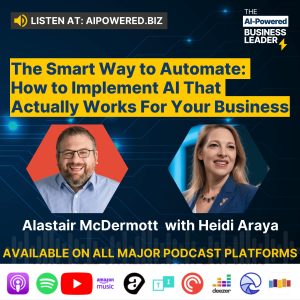Is your business ready for the AI revolution, or are you still stuck in the dark ages?
In this eye-opening episode of The AI-Powered Business Leader, host Alastair McDermott sits down with AI implementation expert Eric Bye to examine how businesses of all sizes can use AI.
Eric shares his wealth of experience in helping companies navigate the complex landscape of AI integration, offering practical advice on how to get started, avoid common pitfalls, and maximize the benefits of this fantastic technology. From identifying key workflows to addressing data privacy concerns, this episode is packed with actionable insights for business leaders looking to stay ahead of the curve.
Some of the valuable topics discussed include:
- How to identify AI opportunities within your existing business processes
- The importance of benchmarking and quantifying AI improvements
- Strategies for overcoming employee resistance to AI implementation
- The future of AI in business, including voice interaction and automation
Whether you’re an AI skeptic or an early adopter, this episode will challenge your assumptions and provide a clear roadmap for leveraging artificial intelligence in your business. Tune in now to ensure you’re not left behind in the AI revolution!
Topic: ai implementation, business processes, workflow optimization, data privacy, employee training, ai adoption, technology integration, business efficiency, automation, digital transformation
Speakers: Guest: Eric Bye. Host: Alastair McDermott.
Key Insights:
- AI implementation should focus on augmenting and transforming jobs rather than replacing them
- Businesses should start by mapping out their workflows and identifying areas where AI can add value
- Data privacy and security are crucial considerations when implementing AI solutions
- Many businesses are informally using AI through personal accounts, which poses risks
- AI can improve both efficiency and the quality of outputs in various business processes
- The future of AI in business includes more automation and proactive task management
- Experimenting with AI tools is key to understanding their capabilities and limitations
Arguments:
- AI implementation requires a collaborative approach to overcome employee skepticism and resistance
- Enterprise-level AI solutions may be too complex and expensive for many SMEs
- The current state of AI agents is still too clunky for widespread business adoption
- Waiting for “perfect” AI solutions may cause businesses to fall behind competitors
Conclusions:
- Businesses should start experimenting with AI now to build a foundation for future advancements
- A balance must be struck between leveraging AI capabilities and maintaining data privacy
- AI implementation should be tailored to each business’s specific needs and risk profile
- Ongoing education and training are essential for successful AI adoption in businesses
Quotes: Eric Bye, [17:29]: “If you ask an employee to create a presentation for, say, a pitch, there’s a lot of there’s something there’s hundreds of 1000s of words or tokens that are unsaid, when you ask them to create that they understand your relationship with the client, they understand the history, they’re probably see seed on a whole bunch of emails, they understand what’s worked, and what hasn’t in the past.” – The AI-Powered Business Leader
Eric Bye, [36:45]: “There’s tons of opportunity today. And I think some people would like to wait until they they see it as perfect. But it’s just different technology that operates differently, which makes people feel a little bit uncomfortable.” – The AI-Powered Business Leader
Find Eric at https://erictronai.com
Find Alastair at https://aipowered.biz/podcast/









